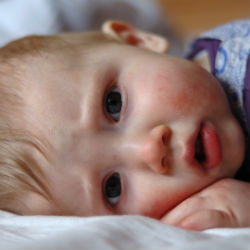Understanding Fifth Disease (Erythema Infectiosum)

A common childhood viral infection, Fifth Disease mainly affects children, but can also be contracted by adults of all ages. While it is generally a mild illness, its characteristic symptoms of fever and red cheeks can be unpleasant. Dr. Caroline Quach, Infectious Disease Specialist at The Montreal Children’s Hospital explains the causes and symptoms of the disease, as well as treatment options.
Causes:
Causes:
Fifth disease is caused by Parvovirus B19 virus and typically affects young infants and children. Since the virus is part of the grouping of normal childhood illnesses, a child will be immune once the infection has run its course. “If you have already had the virus,” Dr. Quach explains, “you will be protected for life, whether you were a child when you contracted it or much older.”
Symptoms:
Symptoms:
Signs of the illness can be quite apparent, but are not always present in all infected individuals. Look out for the following tell-tale signs:
- At the beginning, symptoms may resemble common cold signs, including headache, general malaise and fever.
- Within seven to 10 days, a characteristic rash can develop starting on the face (referred to as slapped cheeks). Sometimes, a lace-like rash, often itchy, can develop on the body and involve the arms, buttocks, and thighs.
- The rash may disappear and then reappear after exposure to heat (i.e. after a bath or shower), sun exposure or after exercising for weeks. However, some children can be infected without ever exhibiting such symptoms.
Incubation and contagion periods:
Incubation and contagion periods:
The typical incubation period of the virus is anywhere from four to 14 days, but may last as long as 20 days, according to the Infection Control Guidelines for Daycare and Child Care Centres outlined by the Québec Ministry of Health and Social Services.
Infected children and adults will be contagious from as much as seven days before and right up to the moment the characteristic rash may appear. “Once the symptoms appear,” says Dr. Quach, “a child is no longer contagious”. For this reason, children who exhibit symptoms of the virus in the form of a rash can attend daycare or school without passing the illness on to their peers. However, these institutions may decide to inform parents about the fact that their children may have come in contact with an infected child for information purposes.
It is important to note that the virus may remain in the body for up to three weeks or more, however, symptoms may not be apparent throughout the entire period.
Transmission:
Transmission:
Children and adults may contract the virus in the following ways:
- By direct contact
- Through breathing, coughing or sneezing
- Indirect contact (by touching surfaces that have been infected)
Risks:
Risks:
According to Dr. Quach, Fifth disease is usually considered to be mild. However, in cases of patients who are immunosuppressed, for example, in individuals with sickle cell anemia, complications may arise. It is therefore important to seek medical attention if a child is particularly vulnerable to infection because of a known medical condition.
In addition, pregnant women who contract the virus may pass the infection to the fetus in some cases. Pregnant women who suspect they have been in contact with parvovirus B19 should therefore contact a health professional.
Treatment:
Treatment:
There is no vaccine or treatment for Fifth disease, says Dr. Quach, who recommends letting the virus run its course.


